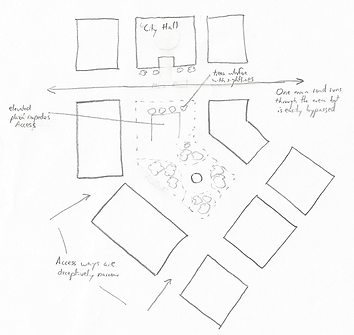"Black Hat Design" for the Public Good

"Risk"
Every year, Northwestern Design offers a special topics course jointly with the art department. The theme this year was "risk" - How engineers mitigate, manage, and hide risks, while artists bring it to the forefront.
We decided to explore the risk of protest and social unrest... but from the perspective of a well-ordered (or autocratic) government for which sustained public dialogue might be "too risky." How might we lay out a public square in front of a city building in order to prevent effective dialogue?
My Role
I partnered with an art student for this project. As "the engineer" of the team, I led the research, 3D-printing, industrial design, and technical writing. We collaborated heavily on brainstorming and concept generation.

Designing the Space
The space is laid out like a one-way mirror in front of City Hall: Protesters can clearly see the building they were protesting between tree trunks, but from the upper windows of City hall, the leaves obscure the crowd.
The plaza itself is elevated, making a longer path back to the ground level. We drew inspiration from how the plaza surrounding the Cloud Gate ("the Bean") in Chicago offers little access to Michigan avenue, despite being directly adjacent. Likewise, buildings are arranged to be barricaded easily; this was inspired by how Trump Tower was sectioned off during protests following the 2016 presidential election.
Making it Uncomfortable
This is an active public plaza that people go to and protest in... but not for too long or to much effect. People want to feel heard, even when they won't be. The plaza therefore has some carefully-designed elements:
-
All benches are constructed of wood and wrought iron, materials that feel welcoming and rustic. They also are curved so that both sitting and lying down for longer than a few minutes becomes painful.
-
A dais allows a speaker to address crowds. It also offers no handrail to rest against. Furthermore, the hard, slightly convex surface leaves the speaker always feeling unbalanced and tired.
-
Streetlights are warmly colored, to avoid "energizing" blue light. The light is then tuned subtly more red than ordinary streetlights, making the entire area feels subconsciously unwelcoming.


Ethical Considerations
This project ran from September to December 2016. What began as a lighthearted take on theoretical ways to control and divert protests became a reflection of the very real protests and fears following the presidential election.
Although we framed and submitted the project as a "Black Hat" design project, the term is a bit of a misnomer. In the hacking world, a "Black Hat" finds and abuses programming vulnerabilities for financial gain. A "White Hat" hacker, by contrast, brings vulnerabilities to light so that a solution can be engineered.
While we often presented this project in a "Black Hat" tone, our goal was to give other artists, designers, and engineers a case study in how easily design principles can be abused, as well as to encourage all people to second-guess the intent of the designed objects and spaces they interact with every day.